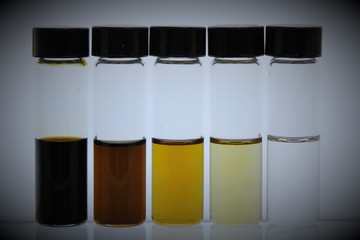Once asphaltene deposition is identified in the field or there is a reason to believe that this problem is imminent as a result of gas injection, for example, active mitigation strategies are needed, which are usually based on continuous injection of various types of asphaltene deposition inhibitors (usually called “asphaltene inhibitors”). The most common types of asphaltene inhibitors are dispersants. Thus in this work we use “asphaltene inhibitor” as a general term to refer to chemicals that intend to mitigate asphaltene deposition and “asphaltene dispersant” a particular type of asphaltene inhibitor, whose mechanism of action is the dispersion of asphaltene aggregates. The utilization of asphaltene dispersants has shown mixed results in the field and in several cases it has been reported that the addition of dispersants can worsen the asphaltene deposition problem. For example, Juyal et al. (2010) reported an increase in the amount of asphaltene deposit collected in a Taylor-Couette cell operated at high shear, and at high pressure and temperature, after addition of two chemicals that were expected to mitigate asphaltene deposition. At concentrations of 500 ppm, Chemicals A and B showed an increase of 17 and 100% on the amount of deposit collected at the end of the experiment, respectively.
| The current testing procedure that is widely used to assess the performance of chemicals is to blame for the poor performance of these chemicals under more realistic conditions. This method, known as the Asphaltene Dispersion Test (ADT), is depicted in Figure 1. ADT uses dead oil samples at ambient conditions to evaluate the ability of a given chemical to delay asphaltene sedimentation upon addition of n-heptane in a 24-hour period. Although this technique is used to screen various chemicals at different dosages, there are several shortcomings that make this method unsuitable for practical application: a. The analysis is done at ambient temperature, b. The oil sample is highly diluted, c. Delayed sedimentation is not an indication of reduced deposition. Actually, it is now well-accepted that the smaller the asphaltene particles the more their tendency to deposit (Vargas, 2010; Akbarzadeh, 2011). |
 |
Figure 1. Asphaltene Dispersion Test (Melendez, 2015).
Lin et al. (2015), from the Biswal group at Rice, showed that the addition of the best dispersant selected from a group of 15 chemicals using the ADT produced, increased asphaltene deposition, according to Figure 2. Melendez et al. (2015), from the Vargas lab group at Rice University, designed and fabricated a novel setup to probe asphaltene deposition under dynamic conditions, whose schematic is shown in Figure 3. This preliminary setup, which was built as a proof of concept, has been used at ambient temperature and pressure. This system is composed by a multi-section column that can be packed with spheres of any given material, e.g. carbon steel. By changing the number and the size of the spheres and the number of sections, the surface area for asphaltene deposition can be efficiently adjusted. PTFE was the selected material for the tubing, the column shell, fittings and valves, to minimize asphaltene interactions and for the good resistance to organic solvents. Variables that can be manipulated in this system are: flow rates, ratio of oil to precipitant, concentration and type of inhibitor, surface area for asphaltene deposition, and the number of pore-volumes. Another significant advantage of the new setup over alternative methods is the possibility of investigating the effect of water, pH and electrolyte content on the precipitation and deposition of asphaltenes, and any potential interactions between water and asphaltene dispersants, or asphaltene and asphaltene dispersants in the presence of water. Moreover, other important applications of the new system may include the analysis of the effectiveness of surface coatings to reduce asphaltene deposition or to analyze the interrelation between corrosion and asphaltene deposition, among others. A new setup to perform experiments at high pressures and temperatures can be built, using materials that can withstand corrosion such as titanium or hastelloy, depending on the particular needs of the project.

Figure 2. Increased asphaltene deposition caused by the addition of a dispersant.

Figure 3. Schematic for novel multi-section packed column to probe asphaltene deposition.
The setup shown in Figure 3 has been already used to evaluate the performance of three commercial dispersants, namely 8, 9 and 15 to reduce asphaltene deposition. For this effect a dead oil sample from the Middle East (oil S) was mixed with n-heptane at a ratio of 30 parts of oil and 70 parts of n-heptane. The ratio of precipitant to oil is set above the onset of asphaltene precipitation, which can be accurately determined using the indirect method. Different experiments were conducted to quantify the amount of asphaltene deposit collected when the various dispersants are used. For all the experiments a constant flow rate of 12 ml/h of the mixture of oil and n-heptane was used and the duration of the experiment was 6 hours.
The performance of the three chemicals 8, 9 and 15 to disperse asphaltenes was also assessed by measuring the light transmittance of the samples at a wavelength of 1100 nm, and at different ratios of heptane / oil. Because the effect of dilution upon addition of heptane has been removed from the measured values, the normalized light intensity is equal to one when no asphaltene precipitation occurs, which, according to Figure 4, for this sample, corresponds to concentrations of n-heptane of 40 vol% or less. At higher concentrations of n-heptane asphaltenes precipitate out, which causes a decrease of the light transmittance. A perfect dispersant would keep the normalized light intensity at one for any concentration of n-heptane. The poorest dispersant would give the same profile as the blank. Thus, from the three tested chemicals, chemical 8 is the best dispersant and chemical 15 is the worst dispersant.

Figure 4. Normalized light intensity at 1100 nm for blends of crude oil S and n-heptane in the presence of different dispersants at ambient pressure and temperature.
A dispersion performance efficiency (DPE) for a given dispersant can be calculated according to Eq. (1). The areas ADisp and ABlank in Eq. 1 and Figure 5 are related to the change on the transmittance of light due to the precipitation of asphaltene with and without the presence of the dispersant, respectively. For a perfect dispersant ADisp should be equal to zero and DPE = 100 %, whereas in the case of the poorest dispersant, where ADisp = ABlank, DPE = 0 %.

Figure 5. Experimental determination of the dispersant performance efficiency (DPE). (a) The red area is related to the performance of a given dispersant, (b) the blue area is for the blank (no-dispersant). The smaller the red area, the better the dispersion efficiency of the given dispersant.
Figure 6 shows the amount of asphaltene deposit collected in the setup depicted in Figure 3 for crude oil S, for the case with no dispersant and for the three dispersants 8, 9 and 15. The mass of asphaltene collected in each case is plotted against the corresponding DPE.

Figure 6. Asphaltene Deposition collected from crude oil S, as a function of the DPE. Ambient T & P.
The results presented in Figure 6 are in agreement with the results from the microfluidic experiment, qualitatively shown in Figure 3. Dispersant 8, which was the best dispersant from the series of 15 chemicals tested using the ADT, increased the amount of asphaltene deposit. On the other hand, dispersant 15, which had a very low DPE value of less than 10%, is able to reduce the amount of asphaltene deposition in almost 50%. Therefore, according to these experiments, the ability of a chemical to disperse asphaltenes is not an indication of their efficiency to reduce asphaltene deposition. In many cases this relationship is actually reversed. For this reason it is of utmost importance to assess the performance of asphaltene inhibitors on their ability to reduce actual deposition (not their dispersion efficiency), under dynamic conditions and at temperatures that are relevant to the production conditions.
References
- Akbarzadeh, K., Eskin, D., Ratulowski, J., et al. (2011). Asphaltene Deposition Measurement and Modeling for Flow Assurance of Subsea Tubings and Pipelines. Presented at the OTC Brasil, Offshore Technology Conference. http://doi.org/10.4043/22316-MS
- Eskin, D., Ratulowski, J., Akbarzadeh, K., et al. (2011). Modelling asphaltene deposition in turbulent pipeline flows. Can. J. Chem. Eng., 89 (3), 421–441.
- Juyal, P.; Yen, A.T.; Rodgers, R.P.; Allenson, S.; Wang, J. and Creek, J. Compositional Variations between Precipitated and Organic Solid Deposition Control (OSDC) Asphaltenes and the Effect of Inhibitors on Deposition by Electrospray Ionization Fourier Transform Ion Cyclotron Resonance (FT-ICR) Mass Spectrometry Energy Fuels 2010, 24, 2320–2326
- Khaleel, A., Rashed, M. A., Mathew, N. T., et al. (2013). Novel Approach to Study the Instability of Asphaltenes in Crude Oil. Presented at the ADNOC Res. Dev. Acad. Conf. ARDAC, Abu Dhabi, United Arab Emirates.
- Lawal, K. A., Crawshaw, J. P., Boek, E. S., et al. (2012). Experimental Investigation of Asphaltene Deposition in Capillary Flow. Energy & Fuels, 26 (4), 2145–2153.
- Lin, Y J. , Tavakkoli, M., He, P., Ji, S Y., Mathew, N., Fatt, Y Y., Chai, J., Goharzadeh, A., Vargas, F. M. and Biswal, S. (2015), Probing Asphaltene Deposition Using Microfluidic Devices, 2015 AIChE Spring Meeting, Austin, TX, April 26-30, 2015
- Lin, Y.J., He, P., Tavakkoli, M., Mathew, N.T., Fatt, Y.Y., Chai, J.C., Goharzadeh, Vargas, F.M., and Biswal, S.L. (2016), Examining Asphaltene Solubility on Deposition in Model Porous Media”. Langmuir, 32 (34), 8729-8734.
- Melendez, Ariana M. “Experimental study of the effect of commercial dispersants on the precipitation, aggregation and deposition of asphaltenes”. M.S. Thesis, Rice University, 2015.
- Rogel, E. (2010). Effect of Inhibitors on Asphaltene Aggregation: A Theoretical Framework†. Energy & Fuels, 25 (2), 472–481.
- Tavakkoli, M., Boggara, M., Garcia M., et al. “Advances in understanding, predicting and mitigating asphaltene deposition during oil production” in “Exploration and Production of Petroleum and Natural Gas.” Editor: M.R. Riazi, ASTM. ISBN: 978-0-8031-7068-1
- Zougari, M., Jacobs, S., Ratulowski, J., et al. (2006). Novel Organic Solids Deposition and Control Device for Live-Oils: Design and Applications. Energy & Fuels, 20 (4), 1656–1663.















